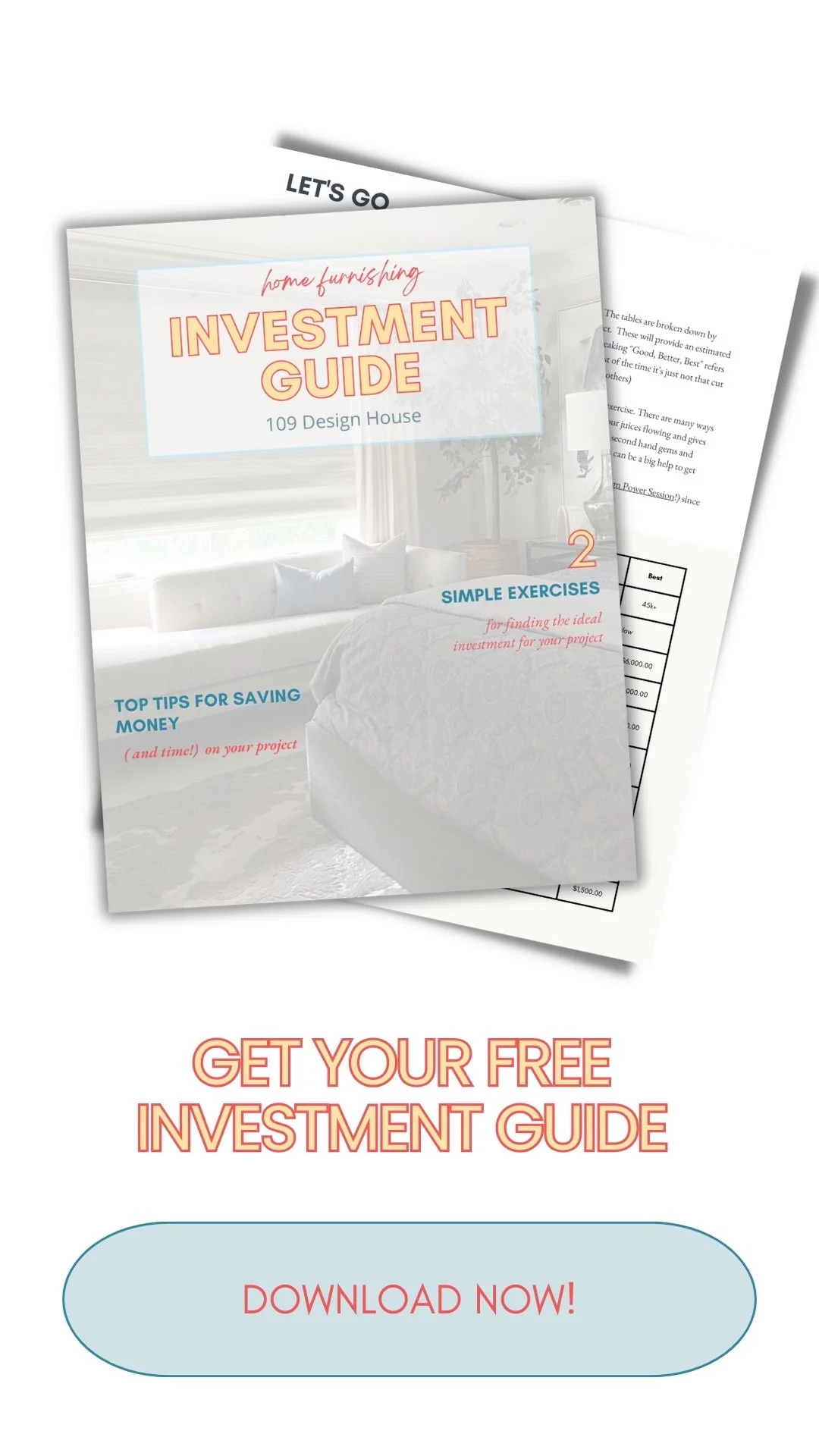The Link Between Home Decor and Mental Wellness: 5 Ways to Improve Both
Do you treat your home’s furniture and decor as an afterthought because your massive to-do list seems insurmountable and completely exhausting?
I totally get it- it doesn’t seem that high on the list when you’ve got meetings to run to, mouths to feed, deadlines to hit and are always picking someone up or dropping them off… it’s nearly impossible to get it all done. And while I love helping clients so that they can maximize the investment made into their home, I also really like helping you take tasks off the long list. Tasks with massive benefit. Because it really does take a village.
I think as a general concept we all understand that our homes play a role in how we feel, but do you know how deep it runs? That there’s science behind that feeling and people are studying this stuff, knowing how impactful it’s going to be? (Not to mention companies investing BILLIONS into this concept at the workplace because they know there’s a good ROI here?)
Here are 5 major factors in how your home affects your mental health and little ways to improve both :)
Click here for a “Jump to the Recipe” style rundown1. Lighting: Studies have shown that exposure to natural light can boost mood and productivity, while poor lighting can cause eye strain, headaches, and fatigue. Proper lighting can also improve sleep quality and regulate circadian rhythms.
Ways to address this in your home:
Keep your windows as unobstructed as possible, or as makes sense, and also make sure that you’re selecting window treatments that align with your goals. I generally choose window treatments that allow for as much natural light as possible to come in, but then also take into account blocking it, as well as manmade light- like street lights or landscape lighting, while you’re sleeping or preparing for sleep. You also want to ensure that they’re providing a sense of security- this may be subconscious, but you can be put on edge when it feels as if someone can see right into your living room while you’re relaxing- making the very task pretty hard.
Experiment with light temperature, especially in areas that aren’t getting a lot of natural light. I’ve been trialing this concept with THESE smart bulbs and have been super impressed so far. They allow you to have a single bulb, but adjust the temperature to completely change the ambience. For instance, I have one in the bedroom that’s set to the “Circadian Rhythm” feature which has it starting off similar to a sunrise, increasing in brightness as wake up time nears. It’s actually been really nice because I’m finding myself waking up without an alarm clock (though I still keep it on as a backup!) and it feels much less jarring than the noise from my phone. Then, if I turn that light on in the evening, it’s a much softer, more amber glow which helps tell our brain that it’s time for a nice slumber. Extra bonus, these ones not only allow you to tune the white light, but have colors too… something I didn’t think I’d use as much as I have!
Another great way to do this is with automatic shades on your windows. They’re blackout through the night so that you’re not seeing your neighbors driveway light, but come morning they slowly let the light in so that you can rise more naturally.
2. Color: Colors can have a significant impact on our emotions and mood. For example, warm colors like red and orange can increase energy levels, while cool colors like blue and green can promote relaxation and calmness.
While those are the color basics and a great jumping off point- take it a step further and understand what colors impact you and how. A great way to do this is find an image that makes you feel the way you’d like to feel in the space you’re decorating. Most recently, I was helping someone with a living room where they wanted to feel relaxed, calm and light. When looking at images, a beach represented that feeling for her. And then more specifically, a coastal sunset with the cool blues and purples of the sky right alongside some warm golden colors of the sun. This was a super easy way to choose colors for her home. First off, if they exist in nature together- they generally work together, so that eases some of the overwhelm of choosing a color palette. Second, if they make you feel in a way that aligns with your goals for the room- you’re definitely on the right track! These colors can then be represented in paint color, furniture, rugs and textiles.
by taking inspiration from images in nature (and art), you can create a color scheme that brings you the feeling you’re looking to have in your dream room
3. Clutter: A cluttered home can cause feelings of overwhelm and stress, while a tidy and organized space can promote a sense of calm and control. Studies have also found that clutter can increase levels of cortisol, a stress hormone.
Having a place for all things is a game changer. And we all know, having less “things” in the first place has the biggest impact. Creating general order is a low cost, high impact way to improve your mental health at home. Beyond the increase in cortisol, studies have also found ties to anxiety, depression, lack of focus and increased general overwhelm when we live in cluttered spaces. Studies in children have found that it can have these effects as well as trouble regulating emotions and general over stimulation- which I believe is the case for us grown ups as well.
While hanging on to things (and hoarding) can be tied to mental health to begin with, sometimes it’s about knowing where to start or just putting off the undesirable task. Whichever it may be, if the task feels too daunting or it’s painful to approach, I’d really recommend looking into getting help! There are wonderful professional organizers out there who will help you tackle these jobs (and learn how to create systems!) as well as mental health professionals that can help you understand how to better your relationship with the things you’re holding onto. The impact of decluttering is hugely impactful on our health and worth serious thought, but when it’s possibly tied to something deeper- be gentle with yourself. The ties that bind us to material objects can be related to trauma or disorder, and those are likely bigger than making different choices or buying some clear bins- it can mean needing a trusted guide to help understand what exactly is going on.
If you’re working on decluttering on your own and unsure of where to start, I’d suggest starting with an “audit”. Much like I tell people when we start a project- be an observer in your own space. Get really curious about how you move and live in everyday moments. What areas are you finding stressful or frustrating?
When you get ready in the morning can you feel tension rise, having to dig in your closet and never being able to find anything, or the right thing? This is a good place to start. And then it's the age old task of finding what works for you. Get help where you need it, by way of advice or hiring someone. And try not to overwhelm yourself, go easy and it’ll get done. There are a lot of resources out there for downsizing strategies and how to donate/sell your items that are super helpful. And creative storage solutions and help with layout when you’re ready for the organizing stage, which we help clients with often. Once you know what you “need” in your space, creating the best way to store and interact with it is the next big life changer.
4. Nature: Exposure to natural elements like plants and greenery has been shown to reduce stress and improve mood. Incorporating natural elements into your home design can help create a calming and refreshing environment.
The studies on this one are wild- this is why large tech companies have spent millions of dollars creating workplaces that incorporate living walls and windows with views of nature- not to mention playing with lighting like described above. It’s shown that exposure to nature (through a window!) can speed physical recovery as well as improve mental health.
The easiest ways to incorporate this into your home are through your windows, like we talked about regarding light above, incorporating greenery and bringing in elements found in nature.
If you’re not a green thumb, you still have options- first, there are many plants that hardly require any caretaking that can make a big impact in your space. ZZ plants, snake plants and Pothos are some of the easiest to care for and don’t ask for much. If you’re completely opposed to the real deal, natural looking faux plants can still give you the feel of having greenery. While you’ll miss out on the air purifying benefits and the actual energy that comes from a living thing, you do get the impression from their organic leaf patterns and branch structure that these realistic stand ins can provide.
In addition, using textures that are found in nature like wood, woven plant materials and even natural stone can provide the warmth that nature gives. This is also true of shapes. Our eye loves shapes found in nature and a big one is a circle. Just like the sun and moon, this shape is representative of life and beauty and it makes us feel good. Not to mention that most of our spaces are filled with hard edges and sharp angles, the soft roundness of nature feels good to balance it all out.
5. Layout and flow: The layout and flow of your home can impact your mental health by influencing how you move and interact within your space. A well-designed space can promote relaxation and encourage social interaction, while a poorly designed space can feel cramped and stressful.
If you’re familiar with Feng Shui, this is where it shines. The layout of your space dramatically impacts the flow of energy in your home. In the most basic way- you can think of your body as the energy and how easily it is to move that body around your room- the traffic patterns, where you have to stop, turn or pivot your energy to shift the direction of your body. This is similar to the energy we talk about that some people find a little too woo. But it is real, I tell you!
For most people, these are often subconscious shifts, but there are certain things that are often repeated in layouts that are actually disturbing to you. Not having enough clearance around certain items or in walkways is a big one- you may not notice it, but it’s uncomfortable (subconsciously) to feel like you may run into something, or that a passage is a little tight. This can also be how working around clutter can feel- which is often why it affects you as it’s described above. And on the flipside, having too much clearance or space can be disrupting! Sometimes there’s too much space and it leaves you feeling disconnected- this can affect not only your energy and the energy of the space, but then how we interact with each other.
This is definitely an area where I love to help people because you feel the shift immediately. If you think you need a second pair of eyes to get some ideas on how to make a big impact, book a quick session! You’d be surprised how much your space can change with some small layout adjustments. And if you’re interested in making some changes on your own, I’d definitely suggest exploring Feng Shui a little bit- it’ll give you some insight into how energy flows and ideas on where certain items can feel good when relocated.
As a recap, or if you like jumping to the point...
1. Lighting: Studies have shown that exposure to natural light can boost mood and productivity, while poor lighting can cause eye strain, headaches, and fatigue. Proper lighting can also improve sleep quality and regulate circadian rhythms.
2. Color: Colors can have a significant impact on our emotions and mood. For example, warm colors like red and orange can increase energy levels, while cool colors like blue and green can promote relaxation and calmness.
3. Clutter: A cluttered home can cause feelings of overwhelm and stress, while a tidy and organized space can promote a sense of calm and control. Studies have also found that clutter can increase levels of cortisol, a stress hormone.
4. Nature: Exposure to natural elements like plants and greenery has been shown to reduce stress and improve mood. Incorporating natural elements into your home design can help create a calming and refreshing environment.
5. Layout and flow: The layout and flow of your home can impact your mental health by influencing how you move and interact within your space. A well-designed space can promote relaxation and encourage social interaction, while a poorly designed space can feel cramped and stressful.
I hope you find these tips helpful. I’ve seen first hand how impactful our homes can be on our overall well being and I strongly believe in it. I can definitely geek out on the science… I just think it’s so cool how accessible it can be to make small tweaks to your existing routines and surroundings and create a massive positive impact. I also very much believe that when we are happier in our homes, we bring that with us and interact in a more positive way with each other. And that will change the world :)
x Kate
Disclosure: Some of the links above are affiliate links. This means that, at zero cost to you, I will earn an affiliate commission if you click through the link and finalize a purchase.







